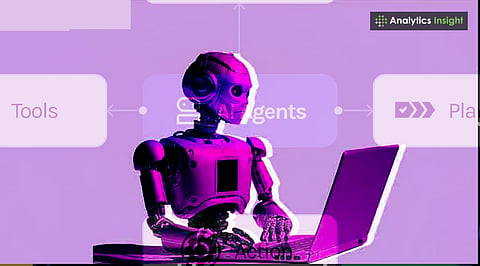

Understand the basics of how AI agents work before starting.
Select the appropriate tools and frameworks, such as LangChain, Python, or GPT APIs.
Test, refine, and train your AI agent for real-world use cases.
AI is no longer limited to large corporations; today, anyone with basic coding knowledge can create an AI helper to manage specific tasks. These agents can book tickets, respond to queries, or analyze information with ease. Knowing how to build an AI Agent gives you a strong foundation in automation.
While the process may appear complex at first, the right techniques and clear steps make building an AI agent achievable. Moreover, as AI tools become more accessible, individuals and small businesses alike can harness their potential to improve efficiency and productivity.
An AI agent is like a computer program that can figure things out on its own. It takes in info, thinks about it, and then makes decisions or offers advice. Think of chatbots and Siri – they're examples.
Many guides explain how to build an AI Agent free using open-source platforms. What's cool is that these AI helpers learn and get better over time, unlike regular apps. With practice and updates, it gets smarter and better at fixing real problems.
Also Read: Why Companies are Investing in Agentic AI for the Future of Business
AI Agents are transforming industries by handling tasks with efficiency. Before you begin, it helps to know how AI helpers work. An agent's work goes like this:
Input – gets information from words, sounds, or sensors.
Modern AI Tools empower developers to create smarter, scalable solutions. Every AI helper should have a simple job. Ask yourself: what should it fix? For example:
A support bot replies to basic questions.
A finance helper watches your spending and sends alerts.
A study friend sums up notes or explains topics.
If you don't have a clear goal, the whole thing can get messy and pointless.
Creating an AI helper doesn't always require coding from scratch. Lots of kits and libraries make things easier. Good options include:
Python – the most used coding language for AI.
LangChain – a kit that mixes AI models with tools.
OpenAI GPT models – for knowing what people are saying.
Rasa – for making conversation-based AI.
If you're a beginner, using ready-made APIs can speed up your process while still letting you tweak things.
An AI helper is only as good as the data it has. For a chatbot, those might be common questions and answers. For a financial assistant, it could be records of financial transactions. Data should be neat, relevant, and in order. Eliminating mistakes and repeating matters is crucial because insufficient data leads to poor results.
Also Read: How AI Agents Work: Exploring The Future of Automation
Got the info? Time to build the model. We teach it by showing them the data so that they can spot trends. It's like a chatbot learning to recognize greetings and respond politely. These models already have tons of data and can be tweaked for certain jobs.
An Artificial Intelligence helper needs to communicate with people. This can happen through:
Text boxes – similar to chat windows on websites.
Voice controls – like smart speakers.
App links – mixing the helper with apps like WhatsApp.
Easy chat is key to making the helper useful.
No AI agent is perfect off the bat. Testing finds mistakes and makes things better. Getting feedback helps fine-tune responses. More new data over time makes the agent more right.
So, once the tests are done, the last thing is setup. That means providing people with a way to access the AI helper, such as through a website, app, or gadget. Often, cloud services like AWS are used to host these large Artificial Intelligence models.
Artificial Intelligence continues to reshape the future of work and technology. Making an AI helper is fun, but problems happen. Some common ones are:
Not enough data to teach it.
High costs are incurred due to tools and hosting.
Artificial Intelligence must be honest and not biased.
Knowing these problems helps you plan and find answers.
Creating an AI helper is no longer as challenging as it used to be. With clear goals, the right tools, and steps, even beginners can create helpful resources. From chatbots to assistants, AI helpers are popping up all over. Starting small and learning is the best way to get good at this.
Q1. What is the first step in building an AI agent?
The first step is defining the purpose and goals of the agent.
Q2. Why is data important for AI agents?
AI agents learn and make decisions based on the quality of data provided.
Q3. Which algorithms are commonly used in AI agents?
Machine learning, natural language processing, and reinforcement learning are widely used.
Q4. How is an AI agent trained?
It is trained by feeding large amounts of prepared data into learning models.
Q5. Why should ethical use of AI agents be considered?
Ethical use ensures fairness, privacy, and trust in the AI system.
